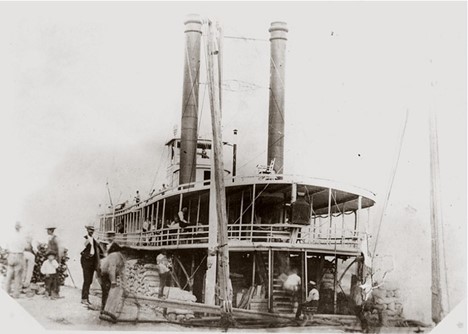By Ann Chrissos
Chesterfield’s location along the Missouri River made it an attractive place for human habitation.
The head waters of this river were created by the confluence of three streams:
the Jefferson, Madison and Gallatin located in southwestern Montana. It then flows approximately 4,000 miles to empty into the Mississippi River.
It flows past Chesterfield some 50 river miles from St. Louis.
Missouri’s earliest inhabitants and explorers, like James MacKay, traveled the river by canoes, flatboats and keelboats.
The
Maid of Orleans was the first steamboat to enter the mouth of the Missouri River in May, 1819 and to travel past Chesterfield on its way to Franklin, Missouri.
Steamboat captains quickly discovered that the lower Missouri River was swift in some sections, slow in others, had many snags and shallow areas making steamboat travel extremely hazardous.
In spite of these difficulties, by 1834, 14 steamboats plied the lower Missouri River on a regular basis.
These boats carried furs, farm produce, tobacco, hemp and other commodities to St. Louis and finished goods and passengers from St. Louis to new western settlements.
As steamboat travel increased, so did steamboat wrecks and several of these disasters occurred near Chesterfield.
The most common causes of steamboat accidents were:
explosions, fires, collisions and snagging.
The latter was the main reason for wrecks near Chesterfield.
Bonhomme Island (lower),
* located in the Missouri River north of the District, had snags along its southeastern shore which resulted in several steamboat wrecks.
One of these snags caused the demise of the
Warsaw in 1846.
This small steamboat was built in 1841.
It was 109 feet long and could carry 70 – 80 tons of freight.
It primarily operated as a tender or auxiliary vessel.
It would transfer cargo from larger boats going up the Missouri River and carry it to stops along the Osage River.
In May of 1844, the
Warsaw was loaded with tobacco and wheat along the Osage River and successfully traveled a flooded Missouri River to St. Louis.
In early January, 1846, this intrepid little steamboat also managed to survive being ice trapped in Glasgow, Missouri.
However, it safely arrived in St. Louis on January 21.
A short time later, Captain Kelsey purchased the boat for $1,800 and insured it for $1,200.
He then agreed to use it to tow the steamer
Lexington from the Osage River to St. Louis.
When the
Warsaw reached Bonhomme Island (lower), it hit a snag and sank.
The insurance company refused to pay because towing violated the contract and Captain Kelsey’s career was also wrecked.
The Golden Age of Steamboating along the Missouri River was from 1855-1860, but steamboats continued to travel and to be wrecked into the early 1900s.
A golden age casualty included the A. C. Goodin, a 351-ton sidewheeler wooden hull packet which was destroyed on April 20, 1857 when it hit a snag at Bonhomme Island (lower).
As example of post golden age steamboating is the
Helena (No. 2). It was a 352-ton stern wheeler built in Pittsburg, Pennsylvania in 1878.
It had twin engines with two boilers.
In 1887, it struck a sang at Bonhomme Island (lower) and sank.
It was soon raised and returned to service, but on October 23, 1891, it once again hit a snag at the same location and disappeared for good.
It’s predecessor, the
Helena, hit a snag at Bonhomme Island (upper) and sank on October 16, 1868.
Other steamboats believed to have wrecked near Chesterfield include the
Emigrant, Fearless (No. 2) and the
Osage. Since Chesterfield was not a steamboat landing like St. Charles or St. Albans, it’s residents could only enjoy the glamorous sight of passing boats or the horrors of watching them sink. The coming of the railroads in the late 19th century made travel and shipping freight faster and safer than steamboats. As a result, the steamboat era came to an abrupt end. Bonhomme Island (upper) in South Dakota also caused steamboat wrecks due to snags.
Helena #2.jpg
Steamboat Helena No. 2 in 1885. Courtesy of the Public Library of Cincinnati,
Photo 1 of 3
Acknowledgement
Thank you to Mark Leach and Michael Meinkoth (Missouri Department of Transportation) for their research assistance.
Sources
Coleman, R. Allen. Twenty Miles of Steamboat Wrecks, 1999.
Flavel, Erastrus. Diary of E. F. Beadle. Entry for Tuesday, May 19, 1857 in Omaha, Meraska.
Giffen, Lawrence Everett. Walks in Water: The Impact of Steamboats, 2001.
Hunter, Louis C. Steamboats on the Western Rivers, 1969.
Pope, James Sterling. The History of Steamboating on the Lower Missouri: 1838-1849 St. Louis to Council Bluffs, Iowa Territory, 1984.




